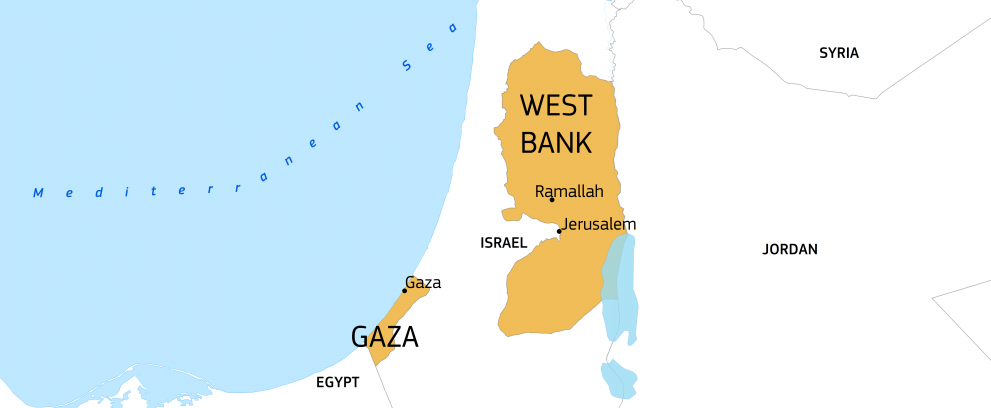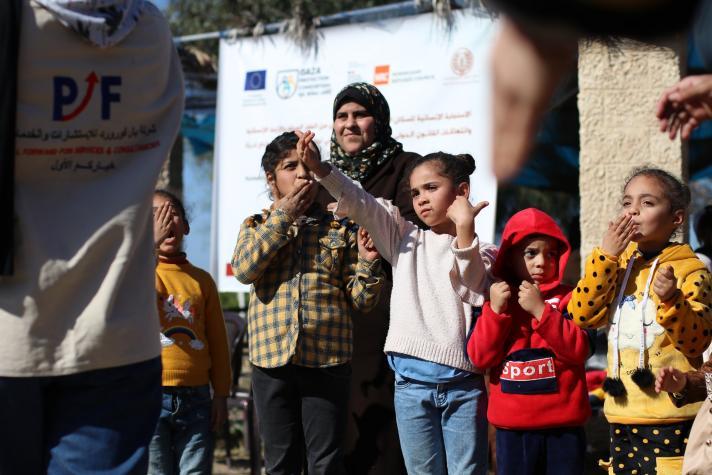Introduction
The EU has been providing humanitarian assistance to Palestinians in need since 2000, supporting people affected by emergencies and shocks.
The protracted humanitarian situation of Palestinians in the Gaza Strip deteriorated dramatically due to the hostilities after the terrorist attack by Hamas of 7 October 2023, on Israeli soil, which left more than 1,200 Israelis dead. The EU has strongly condemned the terrorist attack by Hamas.
The consequent full-scale Israeli military operations, along with the blockade of Gaza, has brought the already dire humanitarian situation there to a catastrophic level for the 2.1 million population resulting in sustained and significant loss of life combined with persistent displacement among civilians. The ceasefire which started on 19 January is expected to ease the humanitarian suffering in Gaza.
The situation across the West Bank, including in East Jerusalem, continues to deteriorate significantly as, since 7 October 2023, the Israeli Authorities have imposed additional restrictions on the movement of 3.3 million Palestinians, which are impacting every aspect of their lives. Intensified military operations, settler violence, and land seizures have also increased, deeply affecting both urban and rural areas.
What are the needs?
According to the Ministry of Health in Gaza, since 7 October 2023, at least 47,100 Palestinians have been killed and more than 111,100 have been injured. Over 13,000 recorded fatalities are children. One quarter of those injured are estimated to have sustained life-changing damage, mostly to their limbs, and will require medium to long-term rehabilitation. More than 2 million Palestinians are without protection, food, water, sanitation, shelter, health care, education, electricity, and fuel.
Over 1.9 million people (more than 90% of the population) have been internally displaced multiple times amidst intensified Israeli airstrikes, ground confrontations, and recurrent evacuation orders.
Intense military operations have severely damaged civilian infrastructures and restricted access to essential services. An estimated of 20% of the population has disabilities, including thousands of children who have lost one or both legs, further exacerbating vulnerability in the region. Currently, only 105,700 children (16% of the total school-age population) have access to some form of education in Gaza. The continued lack of access to education exposes children to immediate protection risks, including child labour, early marriage, and physical injuries. In Gaza, widespread child and family separations have resulted in at least 17,000 unaccompanied and separated children and 35,000 children losing one or both parents. Persons with disabilities face additional barriers due to lack of structured support and assistive devices.
Israeli strikes on hospitals and fuel shortages have crippled Gaza’s healthcare system, leaving thousands of critically ill patients, including women and newborns, without access to life-saving treatment as medical evacuations remain dangerously slow. Over 91% of Gaza's population (1.95 million) faces acute food insecurity, with 876,000 in emergency conditions and 345,000 experiencing catastrophic levels. Approximately 290,000 children under five and 150,000 pregnant and breastfeeding women require feeding and supplements, while over 60,000 children are projected to need treatment for acute malnutrition in 2025. All this while agriculture, fishing and animal farming are in total collapse.
Although a ceasefire took effect on 19 January 2025, the people of Gaza continue to face immense challenges: debris management, retrieval of bodies, unexploded ordnance management to ensure safe movement and the full restoration of all essential lifesaving services and livelihood.
Explosive ordnance, buried within over 42 million tons of rubble laced with hazardous materials, pose long-term threats to human lives and livelihoods, requiring an estimated decade to clear. Winter rains and freezing temperatures are hitting displaced people in Gaza hard. Hypothermia-related deaths underscore the urgent need for shelter and assistance for hundreds of thousands who lack adequate protection. Harsh winter conditions, insufficient heating, and inadequate shelter have led to a rise in life-threatening respiratory infections and hypothermia among newborns and children. Heavy flooding has worsened these challenges, damaging thousands of tents in displacement sites. Delays in distributing winter clothing kits and restrictions on importing essential education supplies have further exacerbated the crisis.
The security situation for civilians and aid workers continues to be fragile with humanitarian aid missions facing a complex operating environment.

The humanitarian situation in the West Bank continues to significantly worsen. This is due to:
- rapid settlement expansion and legalisation heightening the risk of de facto annexation,
- Israeli military operations, including intensified airstrikes,
- intensified search and arrest operations resulting in the detention of at least 10,000 Palestinians held in deplorable conditions
- persistent Israeli settler attacks on Palestinian communities with at least 1,400 settler attacks in the West Bank and over 1,700 people displaced in the context of these attacks since 7 October 2023,
- since 7 October 2023, confrontations between Israeli forces, settlers, and Palestinians have resulted in the killing of more than 1,000 Palestinians, 213 are children.
Humanitarian needs are increasing, driven by escalating violence, widespread displacement, and severe restrictions on access to essential services such as healthcare or education.
Since 7 October 2023, more than 8,700 individuals (including over 3,700 children) have been forcibly displaced. Close to 3,300 individuals were displaced during military operations resulting in extensive damage to civilian and public infrastructure, particularly in Area A and B, including refugee camps. Over 1,800 individuals have been displaced due to home demolitions by Israeli Authorities in Area C and East Jerusalem and 1,700 individuals have been displaced due to settler violence.
As in any other conflict, international humanitarian law must be respected in full to protect civilians and grant unhindered and safe access for humanitarian aid.

How are we helping?
In 2024, the European Commission has significantly increased its humanitarian assistance to Palestine, allocating €237 million in humanitarian aid to vulnerable Palestinians in Gaza and the West Bank.
In 2025, the Commission announced an initial €120 million in humanitarian aid to vulnerable Palestinians.
This funding supports humanitarian organisations working in both Gaza and the West Bank. Despite the considerable insecurity and logistical challenges, EU humanitarian partners continue to respond on the ground, doing their utmost to provide relief in Gaza and the West Bank, often at great personal risk. Access challenges and security concerns in Gaza have forced humanitarian partners operating on the ground to reduce their operations to a bare minimum. Their capacity to deliver is indisputable, but they require access.
The EU continues to deliver humanitarian aid for Palestinians by air and by sea.
Air bridge operations
The EU also launched a Humanitarian Air Bridge (HAB) operation in aid to the people affected by the crisis.
As of January 2025, a total of 64 flights transported over 4,000 tonnes of cargo supplied by humanitarian partners, EU-owned stockpile items, and donations from Member States.
In this regard, so far, supplies from Belgium, France, Germany, Greece, Ireland, Luxembourg, Portugal, Romania, Slovakia, Malta, Italy and Spain have already been transported via Humanitarian Air Bridge flights. Coordination with Member States and partners continues for the further shipment of other life-saving goods.
The aid transported includes medical supplies, shelter, WASH, educational supplies, and medicines among others.
Furthermore, the EU Civil Protection Mechanism has been activated to offer support for repatriation flights from Israel and to support operations for the maritime corridor from Cyprus to Gaza.
Medical Evacuations
The EU, through the EU Civil Protection Mechanism, has played a critical role in facilitating medical evacuations for Palestinian patients in need of life-saving treatment.
Since April 2024, in collaboration with the WHO, Egyptian and Israeli authorities, 6 operations from Egypt and four from Gaza via Israel have successfully evacuated 86 patients and 216 companions to Europe.
EU Member States like Belgium, France, Germany, Greece, Ireland, Italy, Luxembourg, Romania, Slovakia and Spain alongside EU Civil Protection Mechanism participating states Albania and Norway, have provided treatment and/or transport. These missions exemplify the EU's commitment to humanitarian aid and cooperation in addressing urgent medical needs in Palestine.
Before 7 October 2023
In the Gaza Strip, the EU has been providing vulnerable families affected by sudden emergencies and shocks with cash assistance, helping them meet their basic needs. The EU’s assistance has included protection, safe education for children, and health care.
With the support of EU humanitarian aid, the Norwegian Refugee Council (NRC) provided targeted assistance to people in Jabalia, in northern Gaza.

In the West Bank, specifically in Area C, East Jerusalem, and Hebron H2, the EU and several Member States are supporting a consortium of humanitarian partners. They protect communities at risk of forcible displacement because of demolitions, evictions, and settler violence.
EU humanitarian partners provide emergency assistance, legal aid, and access to essential services. The EU also helps improve the living conditions of communities that are barred from accessing or upgrading basic services. For example, by providing shelter and safe sources of water.
The EU advocates for compliance with international humanitarian law and the need to uphold human dignity. It condemns the illegal destruction of Palestinian homes, assets and aid infrastructure, and the forcible displacement of populations.
In both the West Bank and the Gaza Strip, EU humanitarian funding has helped Palestinian children access schools in safe and conducive environments, despite the many obstacles.

The EU also helps strengthen health services to allow essential primary health care and emergency medical services to continue. In addition, it improves access to water, sanitation, and hygiene for vulnerable communities.
The EU supports numerous humanitarian partners in the occupied Palestinian territories: United Nations agencies, the Red Cross and Red Crescent, and international non-governmental organisations.
Since 2000, the EU has provided more than €1.2 billion in humanitarian assistance to help meet the basic needs of the Palestinian population.
* The designation of Palestine shall not be construed as recognition of a State of Palestine and is without prejudice to the individual positions of the Member States on this issue.
Last updated: 28/01/2025
Facts & figures
3.3 million people need humanitarian assistance in the Occupied Palestinian Territory (2.1 million in Gaza and 1.2 million in the West Bank) (UN/OCHA Flash Appeal – December 2024)
Over 715,000 school-aged children in Gaza have no access to formal education since October 2023 (UNOCHA Flash Appeal December 2024)
Over 1.9 million (90% of Gaza population) estimated internally displaced people (UN OCHA)
EU humanitarian funding:
€120 million for 2025
€237 million for 2024
€102 million in 2023
More than €1.2 billion since 2000









